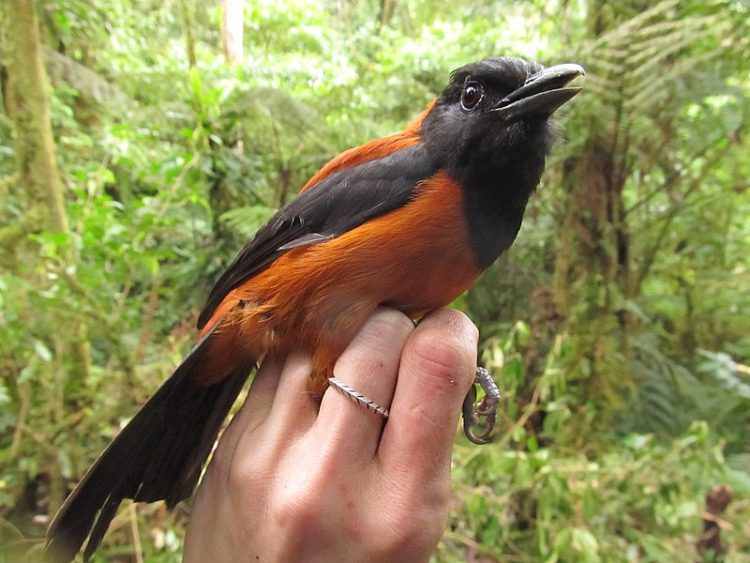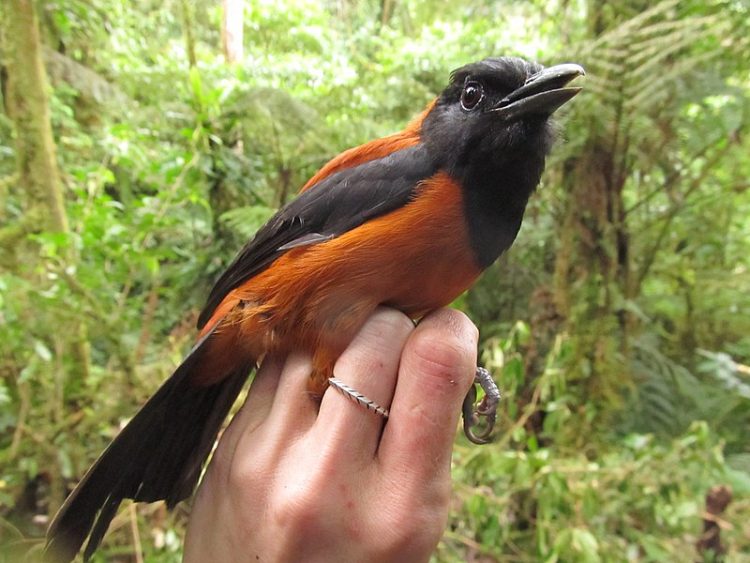The hooded pitohui, a small bird endemic to Papua New Guinea, is the first and only scientifically-confirmed poisonous bird in the world.
The Melanesian people of Papua New Guinea have long known to keep their hands off of hooded pitohui, but to the western world, the bird’s toxic potential was only discovered by chance just over three decades ago. In 1990, ornithologist Jack Dumbacher was on the Pacific island looking for birds of paradise. He had set up delicate mist nets between the trees to catch them and ended up with some hooded pitohui birds in them as well. As he tried to grab the birds out of the traps, they scratched and bit his fingers, and he instinctively put his hands in his mouth to soothe the pain. Almost immediately, Dumbacher felt his lips and tongue go numb. They then started to burn and did so for hours. Later, suspecting that the symptoms were caused by the bird, he took a pitohui feather and put it in his mouth. The numbness and ensuing pain quickly returned. He had unknowingly discovered the world’s first poisonous bird.

Photo: Benjamin Freeman/Wikimedia Commons (CC BY 4.0)
Wikipedia reports that in the same year that Jack Dumbacher made his serendipitous discovery, scientists preparing the carcasses of hooded pitohuis for museum exhibitions experienced numbness and burning when handling them. However, most sources credit Dumbacher for discovering the poisonous nature of the bird. He asked the natives of New Guinea about the pitohui and they all seemed to know about its toxicity. They called it “garbage bird”, as it gave a foul odor when cooked, and was only consumed as a last resort, when no other food source was available.
Wanting to learn more about pitohuis and their poison, Jack Dumbacher sent some feathers to John W. Daly at the National Institutes of Health, who was the world’s leading scientist on natural toxins. During the 1960s, he had identified batrachotoxin as the toxin in the poison dart frogs of Colombia, and, as luck would have it, he found the same family of toxins in the feathers of the hooded pitohui.
The compounds known as batrachotoxins (BTXs) are neurotoxic steroidal alkaloids that work by interrupting the flow of sodium ions through channels in nerve and muscle membranes, causing numbness and burning in low concentrations, and paralysis, followed by cardiac arrest and death, in higher concentrations. They are recognized as the most toxic compounds by weight in all of nature (250 times more toxic than strychnine).
Subsequent research showed that hooded pitohuis stored toxins both in their skin and feathers, but also in their bones and internal organs, albeit in significantly lower concentrations. The fact that this poison was found in the bird’s internal system suggests that they have an insensitivity to it. Interestingly, the concentration of batrachotoxin varies greatly by individual, as well as geographically.
The source of the toxin in hooded pitohuis has been the topic of great debate among scientists, but the general consensus is that the birds don’t produce the poison themselves, but get it from their diet, specifically Choresine beetles that also contain the toxin.
The reason why the hooded pitohui is poisonous is also yet to be determined. Some scientists believe it is a deterrent to predators, but there is little evidence to support this theory. Tiny dart frogs need all the help they can get to keep predators at bay, but a free-flying bird? Plus, the concentrations of batrachotoxin in hooded pitohuis are about three orders of magnitude lower than in the poison dart frogs.
The more plausible explanation is that the toxin on their skin and feathers is designed to keep parasites away. Experiments have shown that lice tended to avoid toxic feathers of hooded pitohui, and those who did infect them lived shorter lives than control lice. However, the batrachotoxins did not seem to have an effect on internal parasites.
So there you have it, the next time you think about poisonous animals, snakes, frogs, spiders and fish won’t be the only ones that come into your mind. There is now a scientifically-recognized poisonous bird and its name is garbage bird hooded pitohui.













